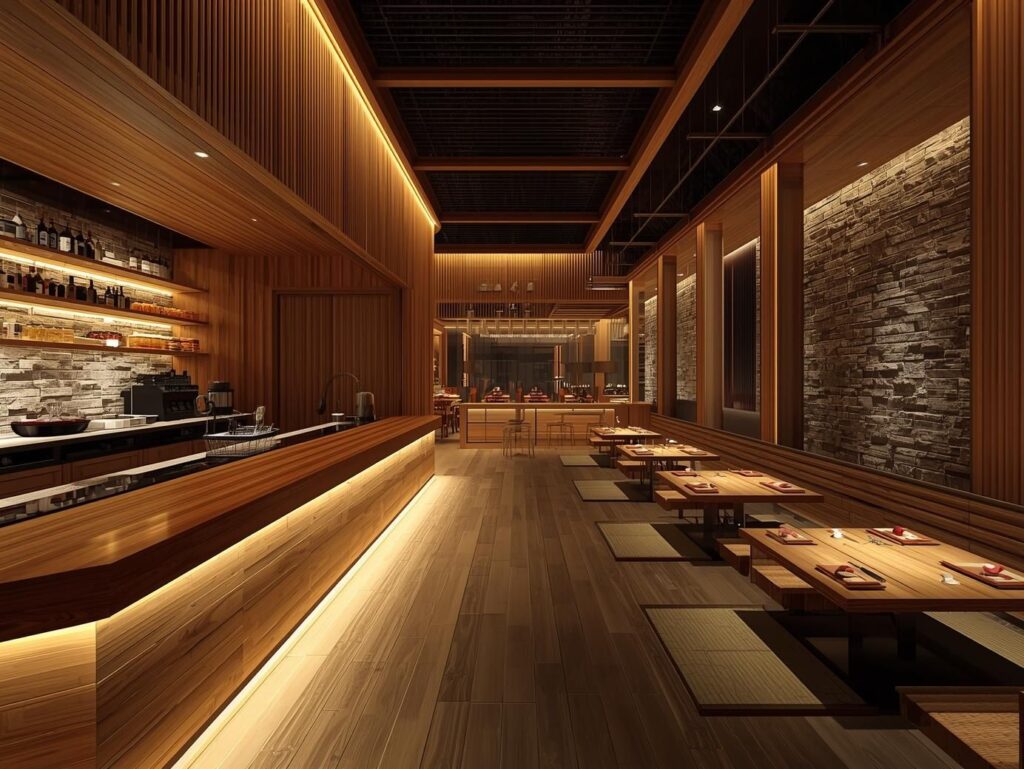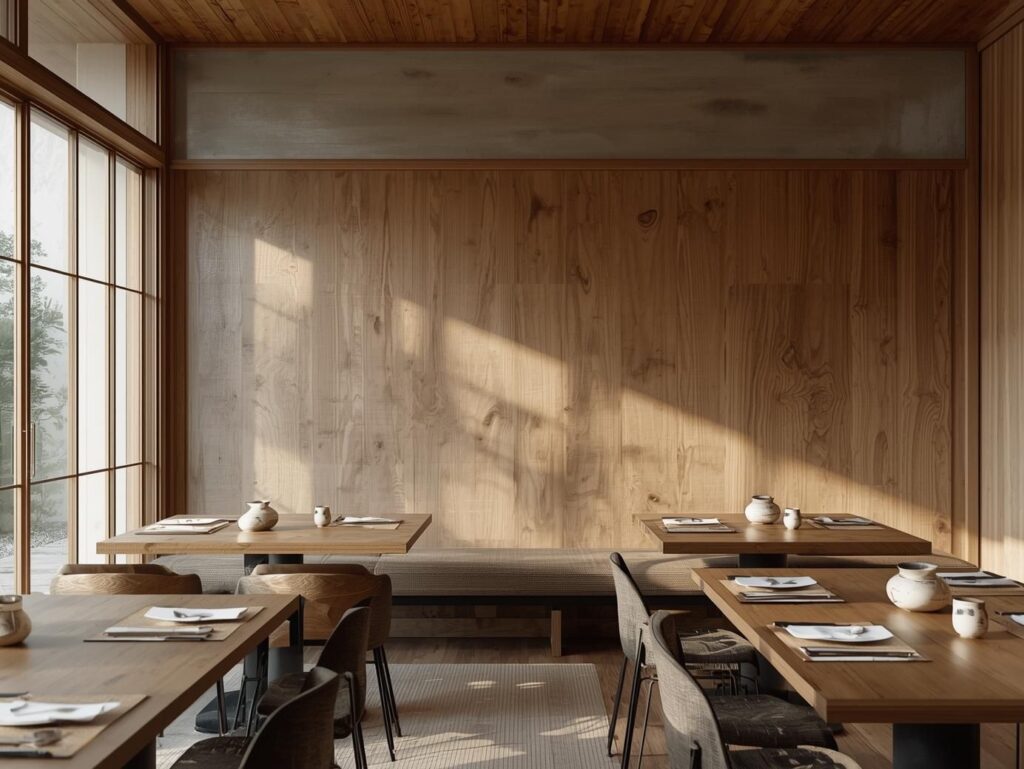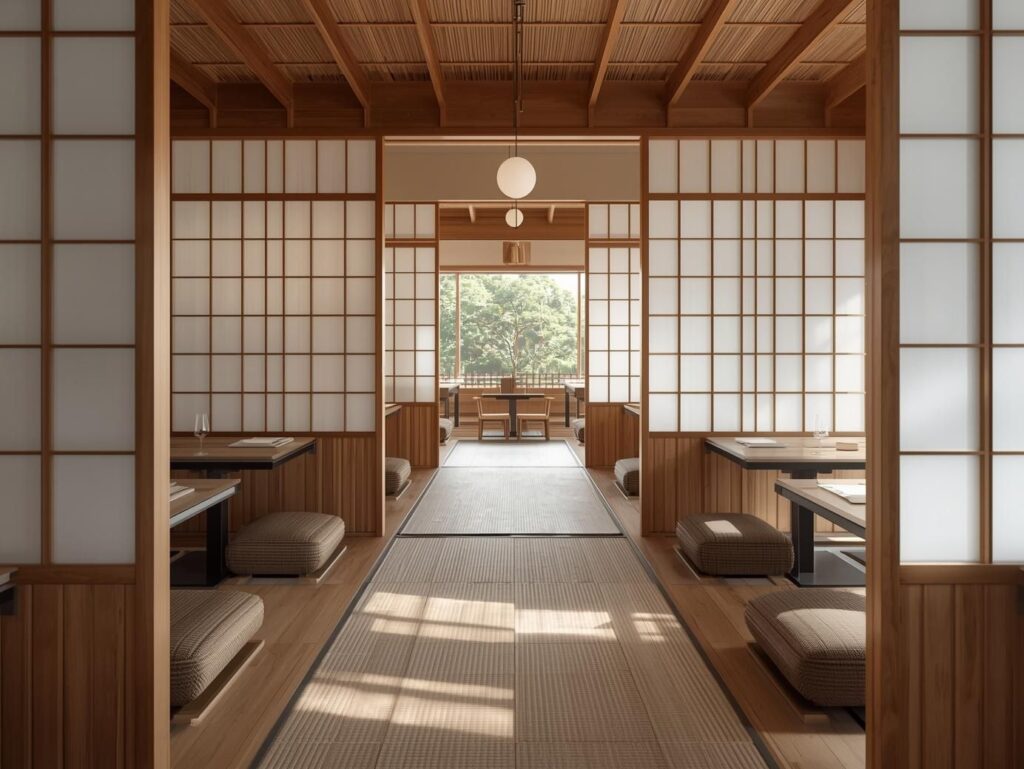There’s something magical about walking into a Japanese restaurant. The air feels calmer. The lighting is softer. Even the silence feels intentional. That’s the power of Japanese restaurant interior design. It’s not just minimalism; it’s mindfulness turned into architecture. And lately, the world is taking notes.
You instantly sense that everything from the grain of the wood to the placement of a single flower has a purpose.
- The Philosophy Behind Japanese Design
- Beyond Minimalism—Why It’s Not Just About Empty Space
- The Soul of Japanese Design: Wabi-Sabi and Harmony
- Natural Materials That Speak the Language of Calm
- Lighting That Paints with Shadows
- Layouts That Encourage Flow and Stillness
- The Power of Nature Indoors: Plants, Water & Stone
- The Modern Twist: Fusion of Tradition and Contemporary Style
- Small Space, Big Impact: Minimalism Meets Function
- Sensory Experience: Sound, Scent, and Texture
- Inspiration for Your Own Space
- FAQs About Japanese Restaurant Interior Design
The Philosophy Behind Japanese Design

At the heart of every Japanese space lies one simple idea: “less, but better.” It’s not about stripping away beauty; it’s about revealing it.
Designers draw inspiration from wabi-sabi, the Japanese philosophy of finding beauty in imperfection and simplicity.
You’ll notice this in how materials are used: the rough texture of untreated wood, the subtle crack in a ceramic bowl, or the uneven edge of handmade paper screens. These aren’t flaws. They’re characters. They make a space feel real, lived-in, and deeply human.
As Japanese architect Tadao Ando once said,
“I don’t believe architecture has to speak too much. It should remain silent and let nature in the guise of sunlight and wind speak.”
Beyond Minimalism—Why It’s Not Just About Empty Space
A lot of people think Japanese interiors are just about minimalism, clean lines, white walls, and barely-there decor. But that’s a Western interpretation. True Japanese restaurant interior design goes deeper.
It’s about balance between light and dark, open and closed, natural and manmade. A restaurant may have simple furniture, but every detail, from the texture of the tatami mat to the scent of hinoki wood, is chosen with intention.
The design isn’t trying to impress you, it’s trying to center you. To make dining feel like a ritual, not a rush.
The Soul of Japanese Design: Wabi-Sabi and Harmony

At the heart of every Japanese restaurant lies the philosophy of Wabi-Sabi finding beauty in imperfection. Uneven ceramics, natural wood grains, and simple, quiet elements transform minimalism into something soulful, warm, and inviting, rather than cold or sterile. Designers use this principle to create a sense of calm, authenticity, and connection.
It’s not about empty space, it’s about intentional simplicity. Every material, angle, and texture matters. Wabi-Sabi turns a room into a space where diners feel grounded, relaxed, and present.
Natural Materials That Speak the Language of Calm
Japanese interiors celebrate materials that feel alive. Think bamboo screens, soft linen drapes, polished wood, stone, and clay accents. Each adds texture, warmth, and a sense of natural luxury.
Modern restaurants often blend these materials with subtle metal accents or polished concrete to create a contemporary edge while retaining their Zen-inspired charm.
Every surface tells a story: wood that’s slightly rough, stone that’s cool to the touch, and paper screens that gently diffuse light. The result is a space that’s both grounded and luxurious.
Lighting That Paints with Shadows
Lighting in Japanese restaurant design isn’t about brightness, it’s about mood and atmosphere. Picture low-hanging pendant lamps, paper lanterns, and indirect warm light. This interplay of light and shadow, known as komorebi, cocoons diners in intimacy without effort.
Soft, layered illumination makes the space feel inviting and calm. It highlights textures, emphasizes natural materials, and subtly guides the eye creating a dining experience that feels thoughtful and serene.
Layouts That Encourage Flow and Stillness

Traditional Japanese spaces are designed with movement and intention. Every path, screen, and seating area has a purpose. Restaurants often use open layouts with sliding doors or partitions to provide flexibility.
Tatami seating, low tables, or strategically placed benches maintain visual openness while offering authentic experiences. It’s a delicate balance; the space flows naturally but still invites stillness, letting diners truly savor their meal.
The Power of Nature Indoors: Plants, Water & Stone
A bonsai on the counter, pebbled pathways, or a tiny indoor koi pond these natural elements transform a restaurant into a mini-retreat. Even a simple branch in a ceramic vase adds serenity.
Biophilic touches like indoor plants, stone features, or water accents remind us of nature. It’s the Japanese way of saying:
“Simplicity is luxury.” Dining becomes a holistic experience where the eye, mind, and soul are nurtured.
The Modern Twist: Fusion of Tradition and Contemporary Style
Contemporary Japanese restaurants are evolving. Designers now mix traditional, raw materials with modern shapes, lighting tech, and bold accents like matte black steel or smoked glass.
This fusion keeps the soul of Japanese design alive while appealing to modern diners. Clean-lined counters paired with tatami-inspired seating, or glass walls with natural wood accents, demonstrate how contemporary minimal luxe can feel grounded, cozy, and sophisticated at the same time.
Small Space, Big Impact: Minimalism Meets Function
Small Japanese restaurants are masters of using every inch wisely. Built-in benches, wall-mounted lighting, and multifunctional storage keep spaces uncluttered but beautiful.
True minimalism isn’t about having less; it’s about using space smarter. Even a tiny restaurant can feel expansive and inviting if every piece of furniture and décor has intention.
Sensory Experience: Sound, Scent, and Texture
Japanese design engages all the senses. Soft background music, subtle cedarwood aromas, the smooth feel of stoneware cups create emotional comfort and lasting impressions.
Texture matters as much as visual design. From rough-hewn wood to plush textiles, the tactile experience adds depth. Guests don’t just see the design, they feel it.
Inspiration for Your Own Space
Whether you’re designing a restaurant, café, or cozy home dining nook, Japanese design offers lessons in calm and connection. Start with neutral tones, embrace imperfections, and let natural light guide your story.
Minimalism here is about presence, not absence. Every detail counts, from natural materials and light play to sensory touches. It’s about creating spaces that feel intentional, human, and unforgettable.
FAQs About Japanese Restaurant Interior Design
1. What makes Japanese restaurant interior design unique?
It’s the balance of simplicity, natural materials, and mindfulness. Every element, from furniture to lighting, is intentional, creating calm and presence.
2. Is Japanese restaurant design always minimalist?
Not strictly. True Japanese design emphasizes harmony and purpose. Minimalism is a tool, not a rule.
3. How can I bring Japanese design elements into my own space?
Use natural materials, soft lighting, and neutral palettes. Add subtle touches like bonsai, bamboo screens, or tatami-style seating.
4. What colors work best for a Japanese-inspired interior?
Earthy, muted tones beige, off-white, charcoal, and soft browns evoke serenity and balance.
5. Why are modern designers so inspired by Japanese interiors today?
Because it’s timeless. Japanese design prioritizes harmony, calm, and emotional well-being exactly what we crave in a hectic world.



